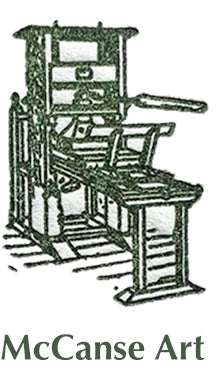Frank Armington
Frank Armington (1876-1941) was born in Fordwich, Ontario. He studied art in Toronto under J.W.L. Forster, portrait painter to a number of Canadian prime ministers and also the uncle of Caroline Wilkinson, a fellow student of Forster’s and Frank’s future wife. Both Frank and Caroline had a wish to pursue their art in Europe, and, moving to Paris at the turn of the century, it would not be long before Frank and Caroline Armington would become internationally recognized for their art, particularly their etchings.

Around 1899, Frank left Canada to study art in Europe. Frank attended the Academie Julian in Paris, a popular school for foreign students, among which included William Brymner, James Wilson Morrice, and A.Y. Jackson, Frank’s friend and peer. While Frank was allowed to pursue his studies in Europe, Caroline’s parents did not encourage her in this respect, and Caroline would not join Frank to study in Paris until some years later. While Frank was at Julian, Caroline worked as a nurse in New York, soon sailing to London and then meeting with the Armingtons (Frank and his family) in Paris for a brief period. That fall, Caroline and Frank married in Paris.

In the early 1900s, as a result from family pressure on Caroline’s side, Frank and Caroline returned to Canada. Here Caroline continued work as a nurse while Frank taught at Havergal College in Winnipeg, a private school for girls, during which time he founded the Manitoba Society of Artists.
But Caroline and Frank were both compelled to return to Paris, the place where they felt their art would thrive best: on this subject, Caroline said, “‘We feel that we can best represent Canada by staying where we are. Here we are not isolated as far as art is concerned and we can make more progress because of the artistic atmosphere, whereas in America it is uphill work. America is commercial and agricultural. Here, art is of as much importance as anything else. If we went back to live we would have to teach, or else paint…portraits, or illustrate. It is very nice for Canada to have pioneers but they do not sell enough to make a living’” (qtd. in Braide and Parke-Taylor, xiv).
Soon the Armingtons returned to Paris, where they would spent nearly the rest of their artistic careers and lives. From there, they travelled extensively through France and Italy, documenting their trips in their etchings, and it was for their work in this medium that the Armingtons would become best known. Writing in Caroline and Frank Armington: Canadian Painter-Etchers in Paris, Nancy Parke-Taylor notes that the Armingtons were both together and separately commercially successful as artists; “the conservative, picturesque quality of their art (especially their etchings) appealed to many, particularly to tourists who purchased the prints as souvenirs of their trips to Europe” (Braide and Parke-Taylor xiv).

Writing further on Frank’s work, Parke-Taylor distinguished it as such: “Frank tended to employ loose, sketch lines executed more portraits and figure studies than Caroline, and chose more often to work in lithography, drypoint and painting” (xv). Frank and Caroline often exhibited at the same salons, shows, and galleries, and although Caroline would be more prolific in her output and become generally better-recognized as an individual artist than Frank, the couple did not feel jealousy: “‘Never [are we jealous of each other]…when one of us carries off an honor at an exhibition the other is as proud as if he or she had done so himself or herself’” (qtd. in Braide and Parke-Taylor xv). Their success and unique relationship as an artist couple propelled the Armingtons to international acclaim during their lifetimes.
In 1939, during an air-raid alarm, Caroline suffered a heart attack, and the Armingtons made the decision to leave Europe for New York. Three days later, Caroline died. In 1940, Frank remarried but himself died a year later in 1941. His second wife and step-daughter moved soon after and reportedly destroyed much of the Armingtons’ photographs and other personal material. As a result, much material on the artists’ lives, both as a couple and individually, has been lost.
Frank held memberships with the Manitoba Art Society (1903), Société des Amis de l’Eau-forte, Paris (1909), the Royal Society of Painter-Etchers and Engravers, London (1910), Société de la Gravure Originale en Noir, Paris (1911), Société de la Gravure Originale en Couleur, Paris (1912), and the Chicago Society of Etchers (1913). His work can be found in many public and private collections, including the National Gallery of Canada and the Art Gallery of Ontario.

Credit: Braide and Parke-Taylor
Written by Mina Ivosev.
Franklin Milton Armington
Education:
- Académie Julian, Paris, under Benjamin Constant and John-Paul Laurens
- Académie de la Grande Chaumiere, Paris
Professional Affiliations
- Manitoba Society of Artists
- Société des Amis de l’Eau-forte, Paris
- Royal Society of Painter-Etchers and Engravers, London
- Société de la Gravure Originale en Noir, Paris
- Société de la Gravure Originale en Couleur, Paris
- Chicago Society of Etchers
Sources:
Braide, Janet; Parke-Taylor, Nancy. Caroline and Frank Armington: Canadian Painter-Etchers in Paris. Peel: Art Gallery of Peel, 1990.
